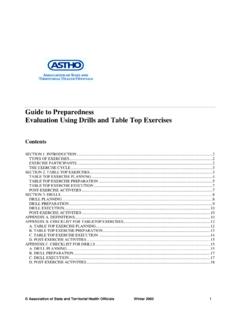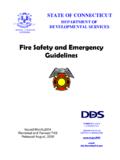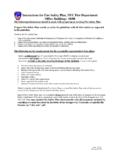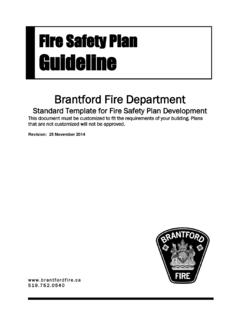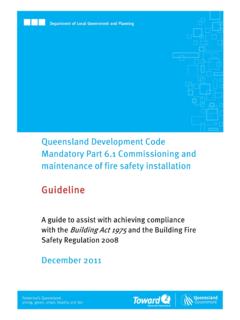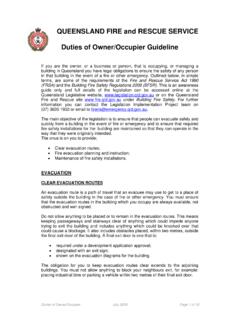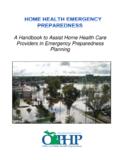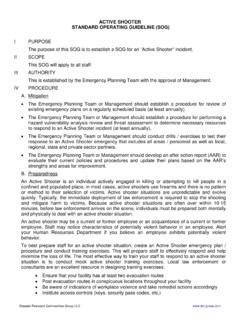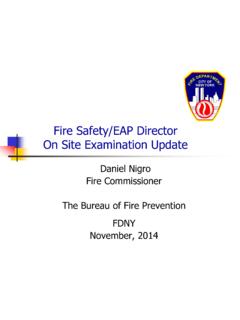Transcription of HOME CARE EMERGENCY PREPAREDNESS
1 home care EMERGENCY PREPAREDNESS A Handbook to Assist home care Providers in EMERGENCY PREPAREDNESS Planning 2012 H C A E D U C A T I O N A N D R E S E A R C H home care EMERGENCY PREPAREDNESS HCA Education and Research 194 Washington Avenue, Suite 400 Albany, NY 12210 Phone 518-426-8764 Fax 518-426-8788 HCA Education and Research is a subsidiary of the home care Association of New York State (HCA). HCA is a statewide not-for-profit organization representing nearly 400 health care providers, allied organizations and individuals committed to the advancement of quality home care services in New York State. HCA and its home health provider members work to promote excellence and support high-quality, cost-effective home care and community services to several hundred thousand individuals who have Medicaid, Medicare, and/or private insurance coverage.
2 This handbook is prepared with grant funding support from the New York State Department of Health. Table of ContentsIntroduction and Overview .. 1 New York State Regulatory Background .. 5 Step1: How Prepared Are You? .. 14 Hazard Analysis .. 14 Planning Priorities .. 17 Comprehensive EMERGENCY Management Checklist .. 18 Step 2: Developing Your Plan .. 24 Planning Assumptions .. 24 Business Continuity (COOP) .. 28 Communication .. 29 Community Partnerships .. 31 Education .. 32 Evacuation and Mandatory Evacuation .. 34 Health Commerce System .. 36 Immunization .. 37 Infection Control .. 38 Memorandums of Understanding .. 39 H O M E C A R E E M E R G E N C Y P R E P A R E D N E S S Mental Health .. 40 Resource Management .. 41 Safety and Security .. 42 Sheltering .. 43 Stepping Down the Response .. 47 Surge Plan .. 48 Transportation Plan.
3 49 Quarantine and Isolation .. 51 Waivers .. 52 Step 3 Evaluate Your Plan .. 54 APPENDIX A: State Department of Health DAL APPENDIX B: Sample Policies and Procedures More APPENDICES are at H O M E C A R E E M E R G E N C Y P R E P A R E D N E S S H O M E C A R E E M E R G E N C Y P R E P A R E D N E S S 1 Introduction and Overview he purpose of this handbook developed by the home care Association of New York State (HCA) with grant funding from the State Department of Health is to assist New York home care provider agencies in writing, improving and evaluating their EMERGENCY PREPAREDNESS plans. An EMERGENCY plan, in the most basic sense, is a guiding document that outlines in detail the systems and protocols which an organization has in place to: ensure the safety of staff and patients, operate within the larger EMERGENCY management system, and maintain continuity of services to patients during and after an EMERGENCY .
4 Some of these protocols, as outlined in this handbook, are required by law and others are best-practices recommended by HCA through consultation with providers working in the home care field. The types of EMERGENCY events covered by an EMERGENCY plan could include natural events like flooding, hurricanes, or winter weather conditions; infectious disease outbreaks; man-made disasters or accidents which cause widespread exposure or dangerous conditions; and others outlined further in this handbook. For home care providers, like all health services organizations, PREPAREDNESS is a critical part of your operation for ensuring patient care and safety, staff security, continuity of business operations and your reputation. While state regulations outline a very basic legal framework and guideline structure for EMERGENCY planning, the most effective PREPAREDNESS and response plans are comprehensive, agency-wide initiatives that provide explicit protocols requiring all organizational staff and departments to work together under a shared understanding and collaborative effort.
5 Format This handbook has several sections, including background on New York State Department of Health (DOH) regulations governing EMERGENCY PREPAREDNESS , a section to assist providers in assessing the strength of their PREPAREDNESS plans, an in-depth look at various protocol areas that should be considered in your plan Chapter 1 T H O M E C A R E E M E R G E N C Y P R E P A R E D N E S S 2development, and tools for ongoing evaluation of your plan s effectiveness. The four basic sections are as follows: New York Regulations. This section provides information on three distinct sources of regulation: 1) Title 10 of New York State law; 2) additional state guidelines issued in 2002; and 2) an EMERGENCY PREPAREDNESS Dear Administrator letter (DAL) issued by the Department of Health in 2005. (Please see Appendix A.) Together, these three items form the basic core regulatory framework governing home care EMERGENCY planning in New York State.
6 These regulations, together with best-practices developed from providers in the field, make for the elements of a comprehensive EMERGENCY plan directing your organization s response and post-incident activities to ensure safety, continuity of care , and continuity of your business operation. Step 1: Hazard Vulnerability or Risk Assessment. PREPAREDNESS Assessment is the process of determining the various risks and threats your agency and patients might face. It involves estimating the impact of both historical and potential events on your business and clinical operations. Step 2: Plan Development. This is the most in-depth and extensive section of the handbook, outlining the various factors that an agency should take into consideration as it develops or improves its EMERGENCY plan. This section of the handbook is divided into a series of topical themes that include such important planning elements as business continuity, surge capacity policies, expectations during an evacuation order, sheltering information, community partnerships, infection control and more.
7 Agencies should read this section carefully and then use the draft policies, available in Appendix B of this handbook, for model protocol language for use in addressing these topics within your EMERGENCY plan. Step 3: Plan Evaluation. Routine evaluation is a critical part of making sure your agency s plan reflects your ability to safely and effectively respond to and recover from a disaster. This section provides information and tools to assist providers in plan evaluation, including protocols for paper review and making updates to your EMERGENCY plan, drills, and use of after-action reports (AARs). In addition to these core elements of the handbook, HCA has also provided a series of appendices with more tools to assist providers. These appendices and other EMERGENCY planning information are available on HCA s EMERGENCY PREPAREDNESS website: Please consult this website regularly for planning tips, educational programs, resources and more.
8 H O M E C A R E E M E R G E N C Y P R E P A R E D N E S S 3 home care EMERGENCY PREPAREDNESS Overview EMERGENCY PREPAREDNESS in health care is the capability of public health and health care systems, communities, and individuals to prevent, protect against, quickly respond to, and recover from health emergencies, particularly those whose scale, timing, or unpredictability threatens to overwhelm routine capabilities. As a provider, you are likely well aware of the unique role that home care plays in response to events like these: a role that reflects your unique niche within the health care system as a whole. This handbook will help you establish protocols for meeting the needs of your patients while maintaining continuity of operations through a coordinated and continuous process of planning and implementation that relies on measuring performance and taking corrective action.
9 All disasters begin locally, and it is important to remember that the response to an EMERGENCY can affect not just your agency, but also an entire community. Emergencies of any size can involve numerous medical and public health entities, including health care provider systems, public health departments, EMERGENCY medical services, medical laboratories, individual health practitioners, medical support services and transportation authorities. This handbook will outline the critical steps your home care agency should take in creating, evaluating and updating your EMERGENCY plan. This plan should establish the role of your agency within the structure of EMERGENCY response, providing clear instructions and best-practices for how each level of your staff prepares for and activates in response to an EMERGENCY . By state regulation and, in many cases, to maintain accreditation agencies are required to have an EMERGENCY plan in place.
10 But beyond compliance with state regulations, there are many other very compelling reasons to maintain an EMERGENCY plan that is as comprehensive as possible. These reasons include: Ensuring the safety and well-being of patients and staff; Maintaining continuity of care to patients; Ensuring agency financial viability and continuity of business operations; Providing legal protection for your agency; Ensuring appropriate utilization of resources; and Supporting your community and community partners during a disaster. H O M E C A R E E M E R G E N C Y P R E P A R E D N E S S 4 home care agencies are required to plan for emergencies of all types (what is known as all-hazards planning). As part of that planning, staff must be oriented to the plan and understand their role in responding to a disaster. As you begin to formulate your plan, it will be helpful for you to remember that EMERGENCY planning for home care is a patient and family centered partnership that includes the patient and family or patient caregivers, your agency and staff, the community, and local and state EMERGENCY planners and responders.
